List of Authors
>>About this blog
Recent blog post
|
[Sam]
April 28, 2017 18:00
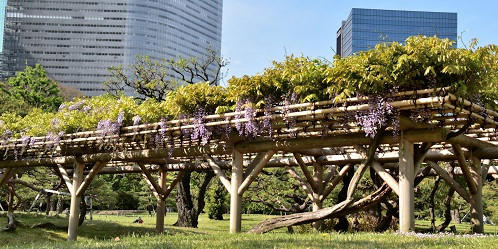
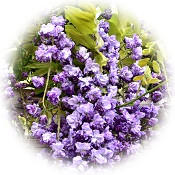 On April 19, the Tokyo Regional Meteorological Observatory announced one of the biological seasonal observation information "Noda Fuji Flowering". (Kitanomaru-koen Park) On April 19, the Tokyo Regional Meteorological Observatory announced one of the biological seasonal observation information "Noda Fuji Flowering". (Kitanomaru-koen Park)
Two days earlier than normal and one day earlier than last year.
The wisteria trellis set up on each of the "Small-shaped islands" in the middle of the "Oden Bridge" in front of the "Yon Liaokan Ruins" in the "Tide Pond" in the Hamarikyu Onshi Garden, "Oden Bridge" It began to be colored with light purple flowers.
Fuji is a vine deciduous leaf Kimoto of the legume family.
The fragrance is fragrant, the flower with the spikes hanging down is splendid, and the swaying in the wind has the taste of being described as "Fujinami".
There are Nodafuji and Yamafuji in endemic species, Japan. Generally, Fuji seems to refer to Nodafuji, but I hear that most of the park is Yamafuji.
On the wisteria trellis at the northern end of the "Oden Bridge", a rare Noda Fuji series "Yaeguro Ryuto" is planted.
Also known as "Peony Fuji".
Most of the stamens are dialectized, and it is a unique flower shape of the so-called "peony bloom".
You can enjoy it until the end of Golden Week.
[Sam]
April 21, 2017 18:00
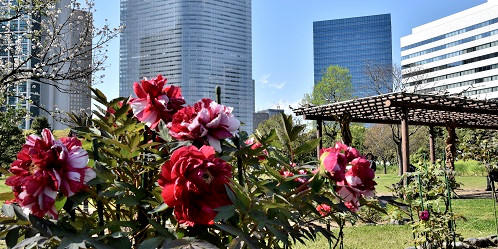
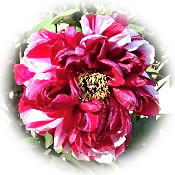
On April 19, the highest temperature in the city center was 26.1 ° C, a summer day for four consecutive days, recording the longest summer day in Thailand as April, and at Botanen in Hamarikyu Garden, "Hyakka no king" Kao ", And the impression that "Fukikusa" and many other peony with many other names began to bloom at once.
I hear that there are about 800 peony of 60 species in the park.
While wrapped in fresh greenery, it has a large flower with a glossy and thin film quality with a diameter of 20 cm, and the flower with a presence is splendid, creating a taste worthy of the name of the queen of garden trees.
There are a variety of ways to bloom flowers, such as single bloom, double-flowered, Senju bloom, Manju bloom, flat bloom, holding, and lion bloom. The color of the flowers is also purple, red purple, black red, red (red), red (red), light red, white, and yellow.
By the way, this year, April 30 is "Botanhanasaku" with 72 climates.
    
[Sam]
April 19, 2017 18:00
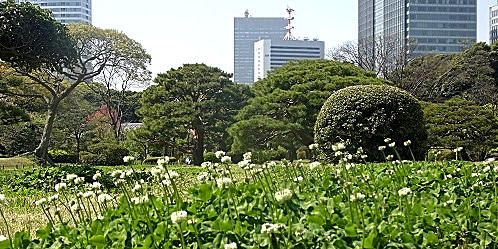
 On March 24, the Tokyo Regional Meteorological Observatory announced one of the Japan Meteorological Agency's biological seasonal observation information, "Shirotsumegusa Flowering". (Kitanomaru-koen Park) On March 24, the Tokyo Regional Meteorological Observatory announced one of the Japan Meteorological Agency's biological seasonal observation information, "Shirotsumegusa Flowering". (Kitanomaru-koen Park)
It is not yet noticeable at Uchibori Square in the Hamarikyu Onshi Garden, but at the site of the Yan Liao Pavilion, the height of Shirotumegusa extends greatly and you can see colonies.
Also known as clover.
The leaves are basically three-leaf compound leaves, sometimes four-leaf or more, and in Western Europe, the three-leaf clover is a symbol of Christianity, and the four-leaf clover resembles the Malta Cross, so it is considered a sign of good luck and happiness.
In Ireland, every year on March 17th, St. Patrick's Day, there is a practice to celebrate wearing a symbolic green or three-leaf clover-designed costume and accessories.
The name "stuffing grass" is said to be derived from the use of dried grass as a packing material for glass products imported from the Netherlands to Nagasaki during the Edo period.
Since nitrogen is fixed by the action of root particle bacteria, it is also used as a greening material that enriches the sober.
Miyazawa Kenji described the "light of nails" in the fairy tale "Polano Square".
Looking closer, the appearance of a small butterfly-shaped flower blooming like a cone from below is like the head of a bird chick whose wings have begun to grow.
[Sam]
April 18, 2017 12:00
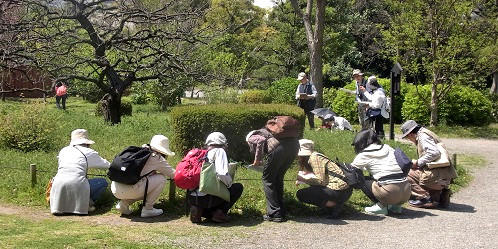
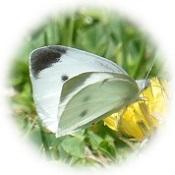
On April 16 (Sun), the "Adult Nature Observation" hosted by the Chuo-ku Environmental Information Center was held at Hamarikyu Onshi Garden. .
10:00~12:00
Lecturer is Nature Observation Instructor of NACOT.
Observe the ecosystem of flowers and creatures that bloom in spring and learn about changes in the environment in nature.
On this day, the maximum temperature of 26.1 ° C was observed in the city center, and this is the first summer day of this year, and the green gradation woven by Aoba Wakaba, which has a slightly different color for each tree in the park, feels even more dazzling.
"Be careful when the sprout of zelkova is irregular" (zelkova sprouts sparsely with a time difference to prevent the sprout from withering due to frost when late frost is likely to come), Matching flower color and shape of insect insects and shape and habit of visiting flower insects, interest in listening to tentumci, abrasives, walks, etc.
If you buckle down and observe the "foot microcosm" closely, you will also get unexpected notice.
Because it was a cultural property garden, it was a fieldwork that once again gave a glimpse of a part of the preservation of the ecosystem in the city center, which was not much modified and was in the preservation of the ecosystem.
From the left, Ojishibari, Onitabirako, Katabami, Snake Ichigo, Kusanoou
    
[Sam]
April 16, 2017 16:00
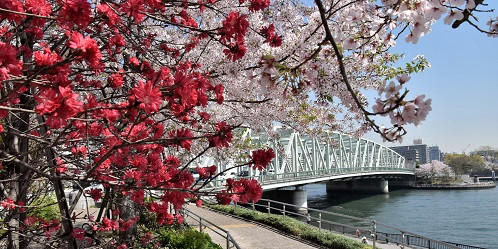
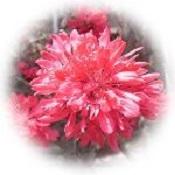 Kikumomomo, which is planted at the southern end of Ishikawajima Park, located along the Sumida River school river from Chuo-ohashi Bridge to the south of Aioi Bridge, in front of Aioi Bridge's complex "Aioi no Sato" is at its best. I am. Kikumomomo, which is planted at the southern end of Ishikawajima Park, located along the Sumida River school river from Chuo-ohashi Bridge to the south of Aioi Bridge, in front of Aioi Bridge's complex "Aioi no Sato" is at its best. I am.
The peaches of the deciduous Odaka tree belonging to the family Rosaceae are broadly divided into "Mimomomo", which treats fruits as edible fruit trees, and "Hana Momo", a horticultural variety that treats flowers as flowering trees.
Kikumomomo (Kikumomomo) is a kind of Hanamomomo. It's also known as Genjigruma.
The name is derived from the fact that the flower shape resembles a chrysanthemum.
The elongated petals, which are said to have changed many stamens, bloom in a row, and it is wonderful to cover the branches tightly.
The gorgeous double-flowered dark red color unique flower appearance creates a symbolic space for the prime of spring.
[Sam]
April 15, 2017 16:00
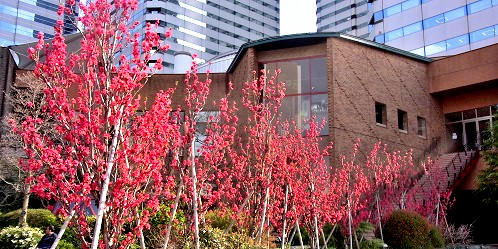
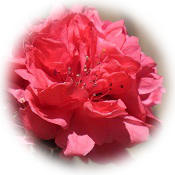
Harumi Triton Square 2F "i green Pocket Plaza Hana, Water, Trees" is an annual mini-garden guided tour to stroll through the park with the guidance of an exclusive gardener. This month will be held on April 13th.
The bright red color of Hana Momo (Terute Beni) on the flower terrace jumps into your eyes first.
Hana peach is a peach that has been improved to appreciate the flowers. The tree shape has standing, broom, and weeping, and the varieties are diverse, such as Yaguchi, Genpei, Terute Beni, Terute White, Kiku peach, etc. .
This season is the season when the number of flowers in the garden is highest throughout the year.
The warm-colored iceland poppy and Marigold hot pack are also bright and spring-like colors.
Bevernamtinus, which blooms white flowers from pink buds, ferricia of Lurihinagiku, and tea flowers that are not a member of plums (Rosaceae), likyubai (Rosaceae genus Rosaceae), red flower Shikinari Ichigo ...
On the green terrace, in addition to the familiar light peach, red and light purple, Shibazakura Candice Tripe with a white cover ring in pink petals, narcissus with a unique flower shape ...
Azaleas such as Hikage azalea, honeybee azalea, and azalea have also begun to bloom.
You can enjoy the grass trees of the time of "laughing mountains" in the soft spring sunshine.
    
From the left, Iceland Poppy, Vivarnamtinus, Ferrisia, Kiba Nakata Kuri, Shibazakura
|
Links
|

 On April 19, the Tokyo Regional Meteorological Observatory announced one of the biological seasonal observation information "Noda Fuji Flowering". (Kitanomaru-koen Park)
On April 19, the Tokyo Regional Meteorological Observatory announced one of the biological seasonal observation information "Noda Fuji Flowering". (Kitanomaru-koen Park)







 On March 24, the Tokyo Regional Meteorological Observatory announced one of the Japan Meteorological Agency's biological seasonal observation information, "Shirotsumegusa Flowering". (Kitanomaru-koen Park)
On March 24, the Tokyo Regional Meteorological Observatory announced one of the Japan Meteorological Agency's biological seasonal observation information, "Shirotsumegusa Flowering". (Kitanomaru-koen Park)







 Kikumomomo, which is planted at the southern end of Ishikawajima Park, located along the Sumida River school river from Chuo-ohashi Bridge to the south of Aioi Bridge, in front of Aioi Bridge's complex "Aioi no Sato" is at its best. I am.
Kikumomomo, which is planted at the southern end of Ishikawajima Park, located along the Sumida River school river from Chuo-ohashi Bridge to the south of Aioi Bridge, in front of Aioi Bridge's complex "Aioi no Sato" is at its best. I am.







